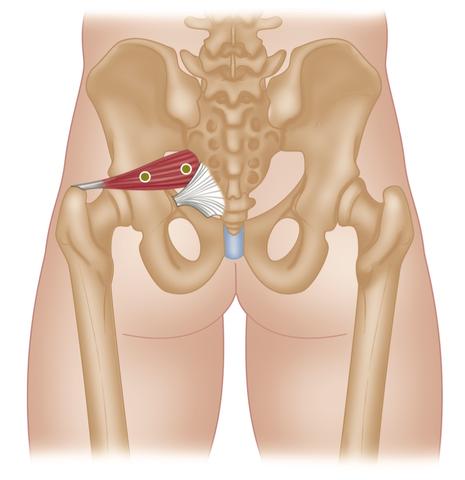Treating Sciatica using Trigger Point Therapy
Posted by Stuart Hinds on
A number of studies have shown the benefits of manual therapy for treating sciatica.
When we analyze the traffic through our clinics at the end of each quarter, sciatica seems to be always up there in the top ten. There are probably two good reasons for this. The first is that sciatica is one of those conditions where the pain can be extremely severe.
The second is that manual therapy has long since been recognized as being effective for providing relief, even by most medical doctors.
In fact, any therapist familiar with trigger point therapy will tell you that they're always upbeat going in to treat sciatica, as the effects of the therapy are in most cases, extremely positive. This is something that has been reaffirmed in a number of studies.
Sciatica is a symptom of an underlying medical condition, such as a lumbar herniated disc, degenerative disc disease, or spinal stenosis. It is not a medical condition in and of itself.
Overview of Sciatica
The condition is characterized by pain that radiates along the path of the sciatic nerve.
This is the largest nerve in the body, beginning at the lower back, and running through the hips and buttocks down to each leg.
In most cases, sciatica affects only one side of the body, but can affect both (bilateral sciatica).
Where symptoms are felt in both legs, it typically means that the cause of the compression, such as a herniated disc, is big enough to compress nerve roots on both sides of the spine.
It is, of course, possible that two separate conditions have developed on opposite sides of the spine, but this would obviously be a rarity.
In most cases, sciatica develops when the sciatic nerve is compressed by a herniated disk or bone spur.
This causes inflammation, pain, and sometimes numbness in the affected side. It's worth noting that it's not unusual to come across sciatica in pregnant women due to an irritation of the sciatic nerve during pregnancy.

Trigger Points in the Piriformis are typically associated with Sciatica
What Are the Symptoms of Sciatica?
The pain associated with sciatica can vary in degree. We see many clients who experience infrequent pain whilst others suffer so severely from the pain as to be largely incapacitated.
Sciatica is often characterized by the following symptoms. The client may experience only one or a combination:
• Constant pain in one side of the leg or buttock
• Pain worsens when sitting
• Burning, tingling, or searing pain in the leg
• Weakness, numbness, or difficulty moving the leg or foot
• A sharp pain which might affect the ability to walk or to stand up
Clients often describe how these symptoms worsen when they cough, sneeze, or sit for a long period of time.
Who Is Prone to Sciatica?
The probability of experiencing pain from sciatica peaks in the 50's and then declines.
It is rare to see clients under the age of 20 suffering from this condition.
Those who suffer from degenerative arthritis of the lumbar spine, lumbar disc diseases, slipped disc, or a trauma or injury to the lumbar spine are the groups who are at a higher risk.
Studies have shown that obesity or even being overweight can increase the risk of sciatica, as the weight will increase stress on the spine.
A job that requires you to twist your back, carry heavy objects, or drive a motor vehicle for long periods of time, may also contribute to increasing the risk factor.
The other group worth noting are diabetes sufferers who are at increased risk because the way that the body uses blood sugar increases the risk of nerve damage.
In summary, whilst there are those cases of sciatica which require more aggressive intervention to deal with the underlying cause, the preferred and most effective treatment in most cases is manual therapy including trigger point therapy, and prescribed stretching and strengthening exercises.
The trigger points commonly (almost always) associated with sciatica are found in piriformis, and gluteus maximus.
It's worth mentioning that Dr. Travell refered to the gluteus minimus as the “Psuedo-Sciatica” muscle because its trigger points can refer pain that mimic the symptoms associated with true neurological sciatica.
Treating Sciatic Pain Trigger Point Therapy Master Class
About the author
Stuart Hinds is one of Australia’s leading soft tissue therapists, with over 27 years of experience as a practitioner, working with elite sports athletes, supporting Olympic teams, educating and mentoring others as well as running a highly successful clinic in Geelong.
Stuart has a strong following of practitioners across Australia and globally who tap into his expertise as a soft-tissue specialist. He delivers a range of highly sought after seminars across Australia, supported by online videos, webinars and one-on-one mentoring to help support his colleagues to build successful businesses.
In 2016, Stuart was awarded a lifetime membership to Massage & Myotherapy Australia for his significant support and contribution to the industry.
This trigger point therapy blog is intended to be used for information purposes only and is not intended to be used for medical diagnosis or treatment or to substitute for a medical diagnosis and/or treatment rendered or prescribed by a physician or competent healthcare professional. This information is designed as educational material, but should not be taken as a recommendation for treatment of any particular person or patient. Always consult your physician if you think you need treatment or if you feel unwell.
